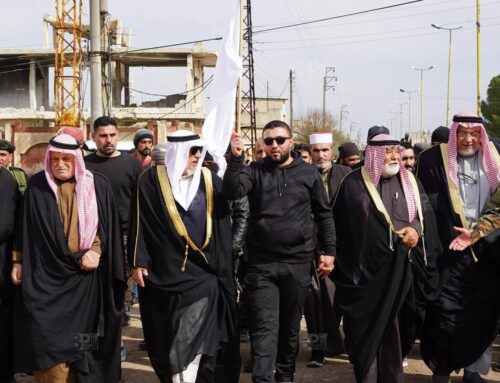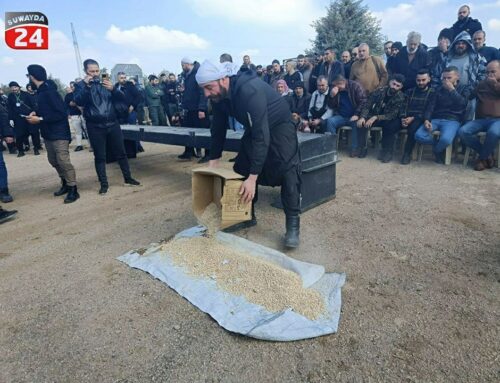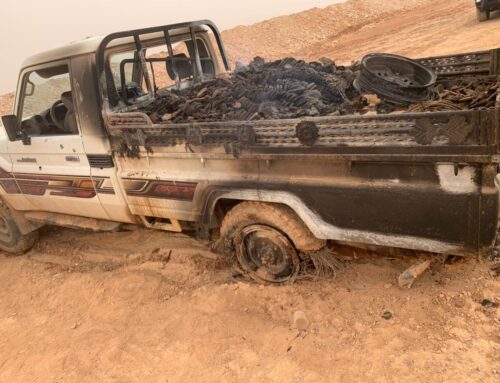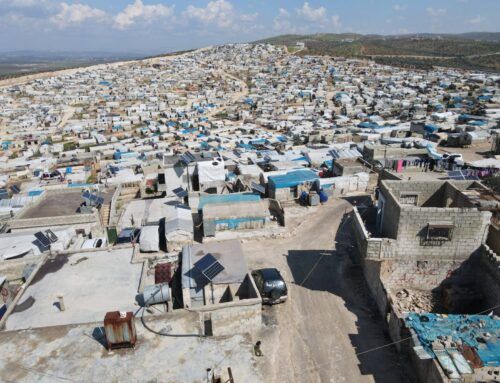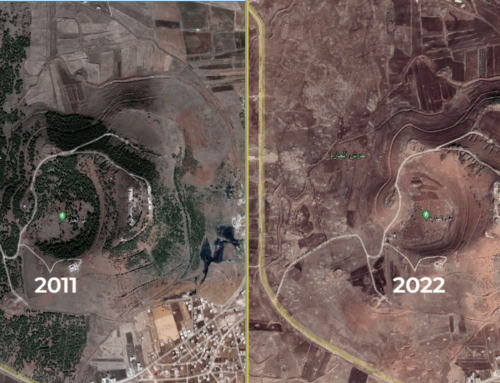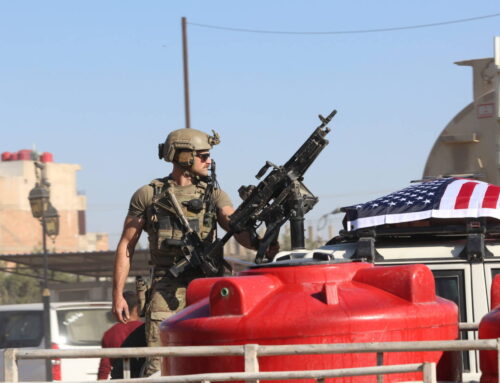‘Impending escalation’ in Daraa? As ceasefire feared to expire, an uneasy peace may be in peril
Syria’s southern Daraa province was among the calmest areas in […]
7 February 2018
Syria’s southern Daraa province was among the calmest areas in the country after a de-escalation deal brokered by Russia, the US and Jordan last July brought a semblance of peace to a provincial capital in ruins.
The deal seemed to hold. During the more than six months since the agreement took effect, both government and rebel forces in southern Daraa city fired intermittent shells and gunfire, but government airstrikes ceased and clashes reduced to skirmishes along the frontlines. Thousands of displaced residents returned home, in the hopes that the battles had finally ended.
But in recent weeks, Syrian army soldiers and allied militias reportedly began moving en masse into the Daraa countryside. One resident told Syria Direct on Wednesday of escalated government artillery fire on local homes.
The ceasefire itself is reportedly rumored to expire in the coming days—as early as Wednesday, a rebel spokesman told Syria Direct last month.
“All the signs are pointing toward impending escalation in the south,” Christopher Kozak, a senior analyst at the Washington, DC-based Institute for the Study of War (ISW), tells Syria Direct’s Madeline Edwards.
Why now?
“It was in all the major power players’ interests to let southern Syria be for a while,” says Kozak, who published a report last week warning of a military escalation in the south. “But I fear that confluence of interests is coming to an end.”
[UPDATE: On February 20, a US official in the region told Syria Direct “the southwest Syria ceasefire announced by the United States, Jordan and Russia in July 2017 is open-ended and has no expiration date.”]
Q: There are widespread rumors that the ceasefire is set to end on February 7. Do we actually see this playing out? And if it does, is there any hope of renewing it?
All signs are [indicating] that by the end of February, the status quo in southern Syria is fundamentally going to change. We also see continued inflow of pro-regime forces down towards Daraa city and Izra in central Daraa province. All the signs are pointing towards impending escalation in the south in the near term. Perhaps [the end is] not exactly February 7, but [it is] certainly within the next month or so.
And that of course is a problem for a number of reasons—not least of which because it threatens violence in an area that has been relatively stable. We have had a relatively effective escalation zone [in the south], compared to other areas of Syria.
Now whether it can be put back together if Assad is truly intent on disrupting the ceasefire—I think that question ultimately lies with Russia. Because as one of the three guarantors alongside the US and Jordan, Russia is really the one that will have to lean on Assad in order to restabilize the south. And whether Russia decides to take a blind eye to [the ceasefire] or to actually actively enforce it, I think, will be critical to whether or not this potential crisis is averted.
We’ve been rather skeptical here at ISW regarding Russia’s intentions inside Syria. This case in southern Syria has been held up by US officials as evidence that there could be a partnership. If that is really true, then this would be where Russia would need to lean in on preserving a ceasefire that its allies seem very willing and ready to disrupt.
Q: Could you help me understand why this ceasefire is feared to end now?
I haven’t seen any official statements about why now, but I can offer some hypotheses.
The first is that from the very beginning of the southern ceasefire deal, when Russia, the US and Jordan announced it, the Syrian regime had always come out and asserted that it was temporary. So that was very constant in their messaging around that time in mid-summer 2017. The ceasefire had to be renewed as long as it was in the regime’s interest to keep renewing it.
This might be the time that the regime decides the temporary ceasefire does come to an end—never mind the fact that the official agreement between Russia, the US and Jordan has no such stipulation.
On the other hand, the timing also has to do with what’s happening on the ground in Syria. The pro-regime coalition has basically finished its main task in eastern Syria. They’re obviously still clashing with ISIS in the Euphrates River valley but in terms of seizing terrain, they have taken the entire left bank of the Euphrates River, finished that operation and shifted back into the west.
I think that what we’re seeing is the next phase of the regime’s strategy, where now that they have the upper hand on the ground in most parts of the country, they’re looking to put increased pressure on southern Syria to either defeat it militarily or, more likely, force the opposition there to accept reconciliation deals en masse and forcibly integrate southern Syria back into the Syrian government.
Q: So it’s basically a question of where the Syrian government is allocating its military resources.
In mid-2017, it was in the regime’s interest to accept the de-escalation zone in southern Syria because the regime’s manpower is very limited with regards to what it can spare.
And so in order to concentrate its efforts on eastern Syria and ISIS, it needed to get some stability in western Syria, which was part of what the establishment of the de-escalation zones was all about—they were about holding down these frontlines and making sure there wasn’t a fundamental threat to the regime while it re-deployed forces elsewhere.
Now that those tasks are done and those forces can come back to western Syria, the regime has less and less of an interest in maintaining the de-escalation zones because ultimately the regime feels that it can, if not win a total outright armed victory over the opposition, use force of arms to force a very favorable political settlement.

Q: Do you think government forces really have the military capacity to operate in southern Syria without leaning on foreign militias there?
I do not expect that they have the capacity to recapture all of southern Syria, even with the help of foreign militias, without a great cost in blood and resources.
Southern Syria has always been a difficult place for the regime to advance, and it’s been a difficult place for the opposition to advance as well. But the regime is very reliant on limited manpower.
Now, as the regime has continued to win victories in Damascus, what you see is the regime more able to amass forces. I do think the regime is capable of making some gains in southern Syria, but the real goal of the regime will not be to completely conquer all of southern Syria unless the opposition forces let them to do that. Rather, [it will be] to seize a couple of key towns, put a lot of pressure on the southern opposition and push them and their benefactors in Jordan to cut a deal.
In terms of the use of foreign militias, I do think that the regime is going to make use of foreign militias and that Iran is not going to miss an opportunity to establish more capability along the Golan Heights border. We already saw this with the offensive on the Beit Jinn pocket. [Ed.: Beit Jinn was one of the last remaining pockets of rebel control in the far southeastern suburbs of Damascus, until pro-government forces seized it last December.] Iranian proxy forces quietly participated but they were certainly there, including Iraqi Shiite militias and Hezbollah commanders, according to our sources. It might have been quiet, but they were there, and they were ostensibly breaking the escalation zone.
Now Iran knows it has to play a careful game and it has to go underground—that’s part of what it’s done during this de-escalation. That’s been one of the flaws of the de-escalation zone—that despite its calls for the departure of Al-Qaeda and foreign Iranian proxy forces, it’s achieved neither.
Q: What kind of pressure do you see these foreign militias putting on Jordan and Israel?
It is a very real concern for the Jordanians to have Iranian proxy militias on their border. Iranian proxy presence in southern Syria close to the Jordanian border, from Jordan’s perspective, risks driving increased refugee flight towards the Syrian-Jordanian border in a way that’s very destabilizing for Jordan.
Jordan has already sealed the borders and is trying to keep the conflict in southern Syria at arm’s length to avoid further ramifications. And Iranian forces being deployed in that area is certainly an escalation that Jordan does not want to see.
We’ve known for a long time that IRGC [Islamic Revolutionary Guard Corps, a branch of the Iranian military] and Lebanese Hezbollah have been scouting locations on the border, raising local proxy forces so that they have enduring capability, setting up bases for rockets and [doing] other things that could threaten northern Israel, with the intent of turning the Golan Heights into a new front against Israel, in the event of another confrontation between Israel and Iran or between Israel and Hezbollah.
Q: Do you think that’s a realistic fear?
I do think that’s a realistic fear. We’ve already seen a number of cross-border attacks on the Golan Heights. They’ve been very limited, but they’ve been a form of signaling, in a way—signaling by Iran, and Hezbollah, either in response to airstrikes that Israel has conducted or a signaling of their presence on the Golan Heights border.
It does provide an opportunity to put additional pressures on Israel in any future conflict, and, at the very minimum, appears strategic to Iran and will give a very major headache to the IDF trying to defend Israel.
Q: You said earlier that it’s very difficult for various military factions to make real advances in southern Syria. What did you mean by that, and what makes the terrain and situation there so difficult?
There’s a geographic factor here, and there are also some intrinsic factors to both sides in the south.
The geographic factor is that southern Syria is the most fortified area in the entire country. The main threat that the Syrian armed forces were directed against, prior to the start of the Syrian revolution, was an Israeli armored thrust from the Golan Heights to Damascus. So the entire swath of terrain between the Golan Heights border and Damascus was heavily fortified. If you look at a map, there’s a military base in every town and every village. So the physical geography is dense with military defenses.
The Syrian Arab Army had three full divisions—the 5th, 7th and 9th—in Daraa and Quneitra provinces, as well as additional military units closer to Damascus (the 4th Armored Division and the Republican Guard). So this was a very heavily fortified area. That made it very difficult for the opposition to seize terrain initially, but once seized, made it equally hard for the regime to take it back.
From the start of the revolution, the Syrian government did not necessarily trust the forces in southern Syria, and so restricted them mainly to defending and holding terrain rather than launching major offensive operations. All of those divisions are still active in southern Syria. They also don’t, in general, conduct major military offensives. They hold terrain, and they protect against the opposition making further gains. In reality, pro-regime gains are made when they shift either foreign militias or lead units such as the Republican Guard or the 4th Armored Division down into southern Syria.
On the opposition side—the Southern Front, while ostensibly an organized body, is really a very loose umbrella coalition of tribal fighters that are very dependent on Jordan in order to mobilize resources and push for an offensive.
At the moment, Jordan is very uninterested in seeing further military offensives in southern Syria. By all reporting that we have, Jordan has steadily cut aid to almost nil over the past year, which is coming right alongside the US also trimming back its covert aid program.
You put those things together, and neither the current pro-regime forces in southern Syria nor is the opposition really in a place to make major offensive gains in southern Syria, which is already difficult terrain. That is why, unless outside intervention occurs—whether that’s the regime sending additional forces, Iran deploying proxies or Jordan and the US reopening the pipeline to the opposition in the south—it becomes very difficult to make gains. That is why this warning update came out, because what we’re warning about is whether there will be an upset to that status quo, with the regime investing additional military capability into the south.
Q: You also commented earlier that the regime doesn’t really have any reason to retake territory in the south unless the opposition “forces” them to do that. What did you mean by that?
The regime does have an interest in taking territory in the south. What I meant by that is that the regime is willing to fight a battle all the way to the Golan Heights border and the Syrian-Jordanian border in order to ultimately recapture that terrain. The regime wants to reintegrate all of Syria back into the Syrian government, and so the regime, if necessary, will go all the way. It might not be this year. It might not be two years from now. But, ultimately, the regime intends to forcibly or politically bring this area back under its control.
Q: Are we seeing the end of the Southern Front’s relevance as a military group in the south?
The Southern Front has never truly been relevant. The most relevant aspect of the Southern Front has been that it has—compared to [factions] in other areas of Syria—proven a very effective counterweight to Islamist groups.
There are still Free Syrian Army groups in other places in Syria, but they’re basically outnumbered by, or beholden to, Hay’at Tahrir a-Sham or to Islamist groups on the ground that have proven more effective.
In the south, the Southern Front remains the dominant opposition player, despite the presence of HTS, Ahrar a-Sham, and ISIS.
With that said, it’s a very loose coalition. It’s not really a group in and of itself. So the relevance of the Southern Front was really only predicated on its ability to coordinate and to effectively manage the disparate opposition resources under its command. That included hundreds of groups at one point. There’s been consolidation since then, but managing all of those resources and directing them toward gains against the regime [gave the Southern Front relevance].
The Southern Front has become less effective at that coordination over time, due in large part to this loss of support from Jordan and the United States. The value of the Southern Front as an umbrella group was that it was the gateway for opposition groups to access these resources from foreign benefactors. That was the purpose of forming this umbrella—to force the opposition to consolidate by creating a centralized player and a centralized gateway through which to funnel resources.
The Southern Front is still relevant, in that as long as it exists, and as long as its component groups hold that ground, it will be a dominant player in southern Syria. But that relevance is waning by the day under current conditions.
Q: Turning to Hay’at Tahrir a-Sham, you mentioned in the recent ISW report that HTS appears to be building up a military presence in southern Syria. Do you think it’s realistic to say that HTS has any sort of capability to maintain a strong foothold there?
It is more realistic to say that HTS is actively working to build a strong footprint in southern Syria. HTS has always had a smaller footprint in the south. It’s never seized the dominant role, similar to what it currently holds in Idlib, but it’s been working toward that goal. It truly wishes to develop a new safe haven in southern Syria to mirror its safe haven in Idlib province in northern Syria.
As the US and Jordan cut off their aid to opposition groups in southern Syria, these opposition groups become much more vulnerable to be receptive to HTS’s message that “we’re the only ones fighting against the Assad regime. Your foreign benefactors want you to sign a deal. Don’t sign a deal that gives up everything you’ve been fighting for. We’re here in the trenches with you. We have resources, work with us.”
Hay’at Tahrir a-Sham has been quietly working to build its military and political governance footprint in southern Syria. The de-escalation zone as well as the cutoffs in foreign aid have been optimal opportunities for HTS to try to start peeling away fighters and opposition groups from the Southern Front.
Q: Do you believe that the ceasefire has successfully returned a semblance of calm to the south?
I agree with the characterization that [the south] has been relatively calm. I disagree with the characterization that this has been a ceasefire. Every day there have been violations, primarily by pro-regime forces: shelling opposition-held areas of Daraa and Quneitra provinces, and planting IEDs along supply roads used by the opposition.
The main problem with the de-escalation zone is that this de-escalation in violence has always been suspect. Violence was liable to return at any moment because there was no fixed mechanism to guarantee a ceasefire. The ceasefire is really only enforced by Russia, which is an active belligerent in the Syrian civil war, so it’s not really a credible guarantor of the ceasefire. There is no fixed mechanism for preventing ceasefire violations or ensuring security and stability.
What we’ve seen is Iran working quietly to build its footprint in the south, Al-Qaeda working quietly to build its footprint in the south and the regime—Assad—messaging that one day, no matter what, the south will return under its control.
The south got a respite primarily because it was in everyone’s interests to look the other way. It was in all the major power players’ interests to let southern Syria be for a while, but I fear that that confluence in interests is coming to an end. I fear that as we move into the next phase of the Syrian civil war—not the post-war phase and not the end of the Syrian civil war but merely the next phase—that the attention and the guns are going to be directed towards southern Syria once again.



